Internet of Things (IoT) technology is popular these days with the demand for connected devices.
The IoT plays an important role in modern warehouses with aid in the automation of warehouse operations.

Examples: packing, putting away, and goods received through the use of connected devices.
The term IoT refers to the collective network of connected devices as well as the technology that enables communication between devices and the cloud as well as between devices.
Nowadays, Beacon technology is also marketable with IoT to manage warehouse systems.
Introduction to Beacon Systems
Beacons are small, wireless devices that can send Bluetooth signals to smart devices nearby.
They are a new advancement in marketing. Beacons in retail can reach customers who have Bluetooth enabled and the relevant retail apps downloaded on their phones.

Beacons broadcast their location, thus if we connect beacons with products, their location will broadcast. We can record the announcement and discover the exact location of the product.
Warehouse Management with Beacon System
It is hard to handle a huge inventory especially when there is a need to manage a warehouse.
Beacons can be programmed to broadcast information to a variety of smart devices with a change of power output.
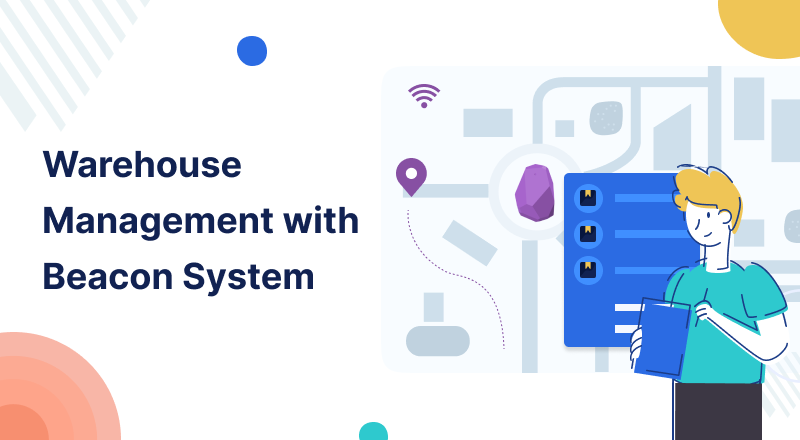
When the device hears the beacons, it tracks what is nearby, and when the device leaves the area, another event is recorded.
By knowing where your goods are in your warehouse in real-time, when they are checked in or checked out, which zone they are in, and the paths they take from entry to exit, among other things.
To be more specific, beacons in warehouses provide a special opportunity for complete changes in daily operations for any logistical need.
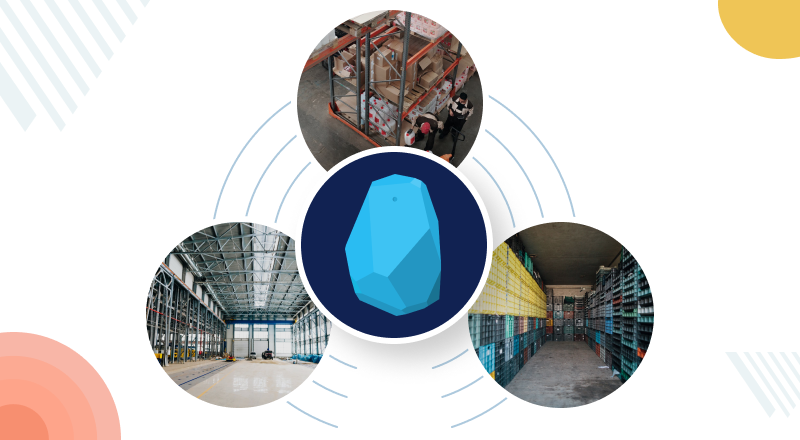
Beacon deploys with the help of BLE technology to the warehouses. BLE tracks every piece of information on warehouse logistics.
BLE Beacons allow the location and movement of a BLE device that you want to track.
They are also responsible for triggering action based on location when a BLE device enters a specific area. Bluetooth Low Energy beacons enable tracking.
How Beacons Aid in Warehouse Management Improvement
Beacon improves the warehouse management process as it has multiple perks to use as mentioned below:
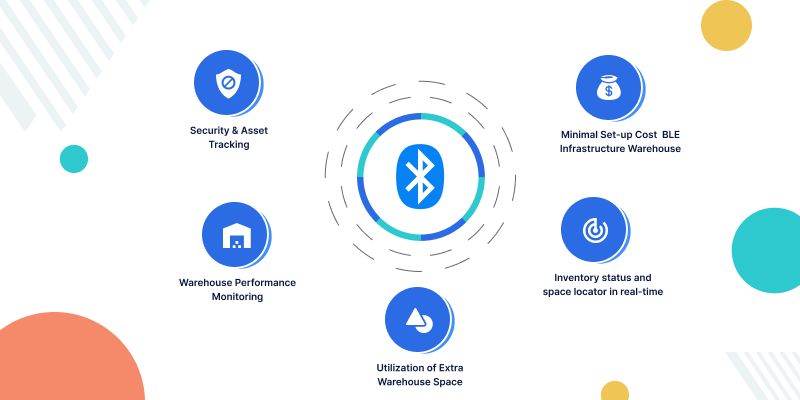
Security & Asset Tracking
The major advantage of Beacon BLE systems in the warehouse is to track.
It tracks the assets by recognizing and tracking the dynamic location which is associated with the mobile device.
It collects the data like; how often the device is used, time of use, who uses it, etc.
And, it helps the warehouse workers to find the asset easily no matter where they are placed.
It also alerts the admin when the secured assets are not properly handled or the wrong person handles the same.
Warehouse Performance Monitoring
Demand fluctuations are always difficult for warehouse managers.
Seasonality stock management demands timely and precise detail about manufacture and retail.
Information gaps between the warehouse and other relevant entities or the industry limit the ability of the distributor to effectively monitor and respond to changes in demand.
Warehouses must use timely and accurate details in plan and forecast demand, as well as know exactly how much time is spent on which forklift.
Where do packages spend the majority of their time? You can generate accurate data and find out where errors occur due to the deployment of beacons in your warehouse.
Beacons can assist to locate seasonal stock and rearrange items by alerting where to place the product with high demand during its need.
Utilization of Extra Warehouse Space
Although inventory audits can assist to identify free space, they can quickly become unmanageable due to the time required to manually scan a large warehouse.
With the deployment of beacons in warehouses, it is possible to track assets, you allow them to store in place and easily found when needed.
Beacons provide instant clarity of available space, allow you to audit your goods, and load or unload them in the most efficient location.
Dynamic Inventory status and space locator
Manual inventory counts not only too much time taking but also halt other operations while performing the count.
We can avoid this wasteful process with BLE deployments, which allow for quick counts of anything tagged and within sensor range.
There is no need for disturbance, downtime, or additional staff to complete the inventory.
You can even count inventory by category of goods or any other metric if you properly segment stored goods when assigned a tag to them.
Dynamic inventory status updates also calculate the amount of available free space at any given time simple total capacity minus current inventory equals available space.
Minimal Setup Cost BLE Infrastructure Warehouse
Due to the size and nature of the initial deployment, the initial costs for a BLE infrastructure can be less than a quarter of the cost of a comparable RFID project.
Even without knowing the specifics, it is simple to state that BLE is far more economical than other solutions.
Ongoing costs are small, mostly in the form of battery replacements every now and then.
Savings are available immediately and in a variety of forms.
The efficiencies gained from optimized staff and asset use, the elimination of human error, and real-time clarity into available inventory and space all have a direct impact on your bottom line.
Inhouse Map Tracking Using Beacon Systems
It is crucial to manage the warehouse for any business when it has a large warehouse. For inventory placement issues, Bluetooth Low Energy beacons are the most effective solution.
It is the leader of the previous Bluetooth technology, which is more sustainable.

Warehouses use BLE beacons to determine zone mapping in order to organize the floor plan.
It also aids in indoor navigation for guiding employees and supports asset tracking with beacon tags for the recognition and tracking of goods.
Bluetooth Low Energy Beacons with LED lights are installed in the tracking boxes.
The Beacon LED flashes as soon as the employee approaches the goods, making recognition easier, based on proximity logic.
Other Trends for Warehouse Management
There are some other IoT technologies for warehouse management that are trending these days. Let’s discuss it in brief:
Drones
Drones provide a profitable and efficient way for managers to keep track of inventory in real time. IoT devices will be able to scan any item without human interference, lowering the risk of accidents or errors.
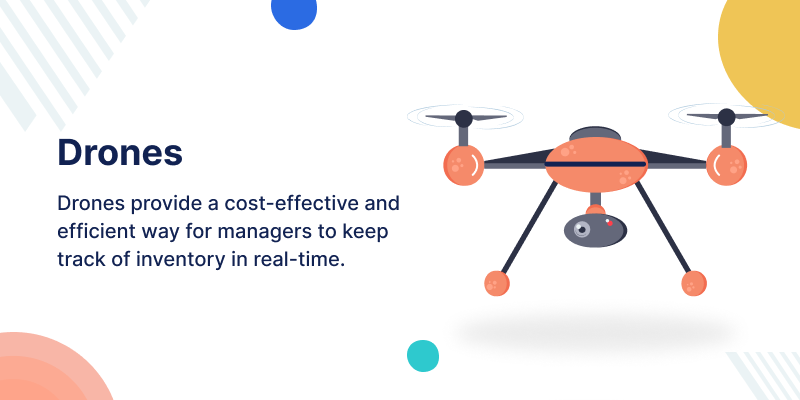
Moving items will become more manageable as well as locating them across the floor.
Drones and humans can work in tandem to manage inventory, reducing unnecessary workload while providing maximum security.
Humans can handle their part of the work during the day. However, remote-controlled laser vision-enabled drones can handle the rest of the work.
Blockchain Item Tracking
Blockchain is changing the warehousing industry. The technology gives warehouse and inventory managers real-time clarity into how well their products are selling as well as tracking their physical location.
It saves money on both labor and nonfinancial resources. The blockchain enables store managers to detect theft more quickly.

They can pinpoint exactly where something went missing while also keeping track of sales across multiple stores.
Warehouse managers will be able to forecast demand using Blockchain data logs.
The new technology makes it easier to meet supply chain regulatory requirements by attaching to the chain of custody guidelines.
Robots & Guided Vehicles
Another way to boost warehouse productivity is to use independent technologies.
Without the need for human intervention, automated guided vehicles can calculate the shortest route to any path and restock the inventory.
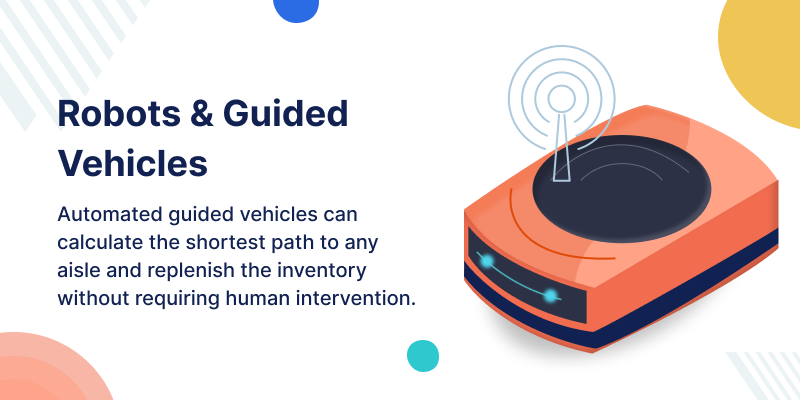
Using AGVs and mobile robots in warehouses is nothing new as Amazon employs over 100,000 robot workers in an IoT-enabled smart warehouse.
Vision Picking
Smart glasses allow workers to handle work with free hands and are ideal for picking items and transporting them to different zones in a warehouse.

Workers can speed up their work with the use of connected wearables with simple interfaces.
Workers who are new to the warehouse must learn how to operate the devices. If they have smart glasses, it takes less time than remember the location of each type of item and manually locating it.
Data Analysis through RFID & IoT
Radio Frequency Identification is a wireless system made up of two parts: tags and readers.
A device that contains one or more antennas is known as a reader and receives signals from RFID tags.

RFID tags make it easier to keep track of your physical inventory. Warehouses can save time by using these to locate products across the floor. RFID smart cards are also in use by organizations for better employee management.
It is easy to track the wastage of products, resulting in smaller economic losses for the company.
You can keep track of each product with the use of RFID devices in your store to ensure that you move the right items at the right time.
IoT technology also allows you to monitor inventory levels, ensuring that there is never too much or too little stock on hand at any given time.
Real-Life Examples of IoT
The IoT has many uses in real-life scenarios. Some of them are as below:
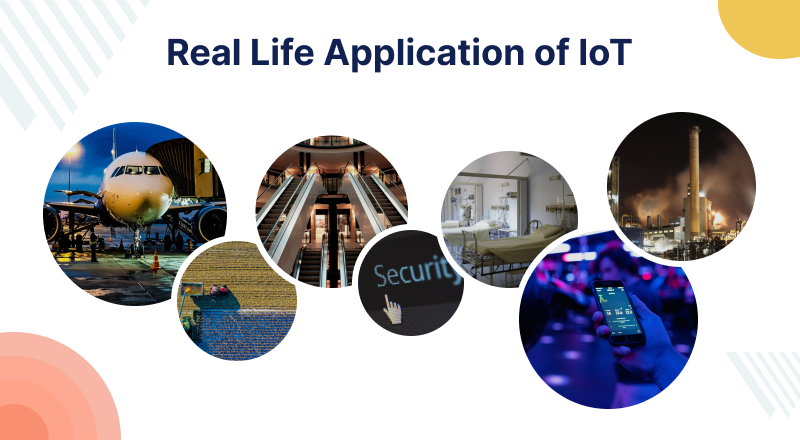
- Airports
- Farming
- Shopping Malls
- Biometric Security systems
- Healthcare systems
- Tracking and monitoring systems
- IoT-connected factories etc.
Wrapping Up
The IoT is having a huge impact on warehouse management systems. This helps the warehouse manager to manage the inventory of the warehouse. That is all about IoT-based Warehouse Management using Beacon System.
If you have any other queries, please contact us at Webkul Support System.
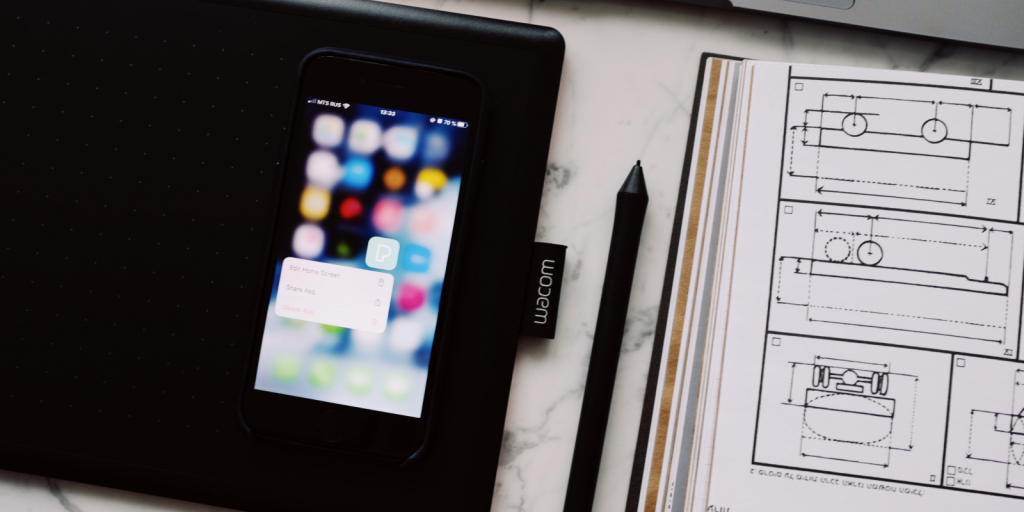

Be the first to comment.